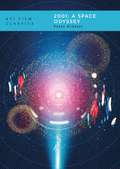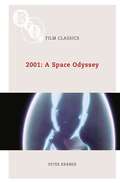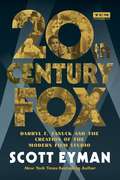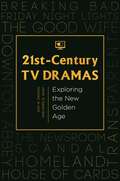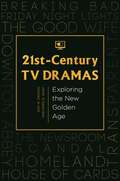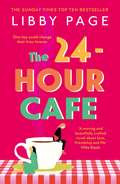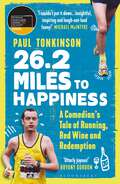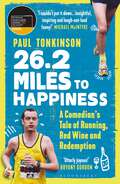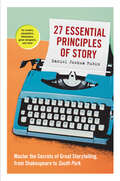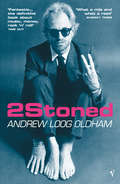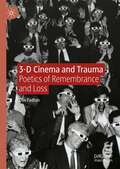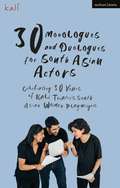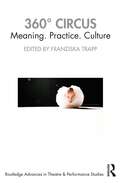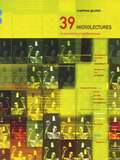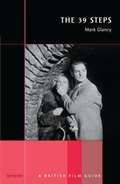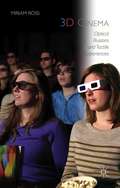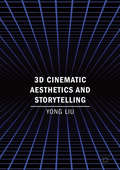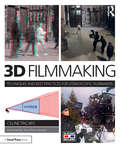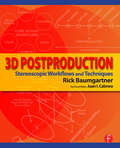- Table View
- List View
2001: A Space Odyssey (BFI Film Classics)
by Peter KrämerStanley Kubrick's 2001: A Space Odyssey (1968) is widely regarded as one of the best films ever made. It has been celebrated for its beauty and mystery, its realistic depiction of space travel and dazzling display of visual effects, the breathtaking scope of its story, which reaches across millions of years, and the thought-provoking depth of its meditation on evolution, technology and humanity's encounters with the unknown. 2001 has been described as the most expensive avant-garde movie ever made and as a psychedelic trip, a unique expression of the spirit of the 1960s and as a timeless masterpiece. Peter Krämer's insightful study explores 2001's complex origins, the unique shape it took and the extraordinary impact it made on contemporary audiences, drawing on new research in the Stanley Kubrick Archive to challenges many of the widely-held assumptions about the film. This edition includes a new afterword by the author.
2001: A Space Odyssey (BFI Film Classics)
by Peter KrämerStanley Kubrick's 2001: A Space Odyssey (1968) is widely regarded as one of the best films ever made. It has been celebrated for its beauty and mystery, its realistic depiction of space travel and dazzling display of visual effects, the breathtaking scope of its story, which reaches across millions of years, and the thought-provoking depth of its meditation on evolution, technology and humanity's encounters with the unknown. 2001 has been described as the most expensive avant-garde movie ever made and as a psychedelic trip, a unique expression of the spirit of the 1960s and as a timeless masterpiece. Peter Krämer's insightful study explores 2001's complex origins, the unique shape it took and the extraordinary impact it made on contemporary audiences, drawing on new research in the Stanley Kubrick Archive to challenges many of the widely-held assumptions about the film. This edition includes a new afterword by the author.
2001: A Space Odyssey (BFI Film Classics)
by Peter KramerStanley Kubrick's 2001: A Space Odyssey (1968) is widely regarded as one of the best films ever made. It has been celebrated for its beauty and mystery, its realistic depiction of space travel and dazzling display of visual effects, the breathtaking scope of its story, which reaches across millions of years, and the thought-provoking depth of its meditation on evolution, technology and humanity's encounters with the unknown. 2001 has been described as the most expensive avant-garde movie ever made and as a psychedelic trip, a unique expression of the spirit of the 1960s and as a timeless masterpiece. Peter Krämer's insightful study explores the complex origins of the film, the unique shape it took and the extraordinary impact it made on contemporary audiences. Drawing on new research in the Stanley Kubrick Archive at the University of the Arts London, Krämer challenges many of the widely-held assumptions about the film. He argues that 2001 was Kubrick's attempt to counter the deep pessimism of his previous film, Dr Strangelove (1964), which culminates in the explosion of a nuclear 'doomsday' device, with a more hopeful vision of humanity's future, facilitated by the intervention of mysterious extra-terrestrial artifacts. This study traces the project's development from the first letter Kubrick wrote to his future collaborator Arthur C. Clarke in March 1964 all the way to the dramatic changes Kubrick made to the film shortly before its release by MGM in April 1968. Krämer shows that, despite – or, perhaps, because of – Kubrick's daring last-minute decision to turn the film itself into a mysterious artifact, 2001 was an instant success with both critics and general audiences, and has exerted enormous influence over Hollywood's output of science fiction movies ever since. The book argues that 2001 invites us to enjoy and contemplate its sounds and images over and over again, and, if we are so inclined, to take away from it an important message of hope.
20th Century-Fox: Darryl F. Zanuck and the Creation of the Modern Film Studio (Turner Classic Movies)
by Scott EymanFrom New York Times bestselling author Scott Eyman, this is the story one of the most influential studios in film history, from its glory days under the leadership of legendary movie mogul Darryl F. Zanuck up to its 2019 buyout by Disney.March 20, 2019 marked the end of an era -- Disney took ownership of the movie empire that was Fox. For almost a century before that historic date, Twentieth Century-Fox was one of the preeminent producers of films, stars, and filmmakers. Its unique identity in the industry and place in movie history is unparalleled -- and one of the greatest stories to come out of Hollywood. One man, a legendary producer named Darryl F. Zanuck, is the heart of the story. This narrative tells the complete tale of Zanuck and the films, stars, intrigue, and innovations of the iconic studio that was.
21st-Century TV Dramas: Exploring the New Golden Age
by Amy M. Damico Sara E. QuayIn its exploration of some of the most influential, popular, or critically acclaimed television dramas since the year 2000, this book documents how modern television dramas reflect our society through their complex narratives about prevailing economic, political, security, and social issues.Television dramas have changed since the turn of the 21st century—for the good, many would say, as a result of changes in technology, the rise of cable networks, and increased creative freedom. This book approaches the new golden age of television dramas by examining the programs that define the first 15 years of the new century through their complex narratives, high production value, star power, popularity, and enthusiastic fan culture.After an introduction that sets the stage for the book's content, thematic sections present concise chapters that explore key connections between television dramas and elements of 21st-century culture. The authors explore Downton Abbey as a distraction from contemporary class struggles, patriarchy and the past in Game of Thrones and Mad Men, and portrayals of the "dark hero protagonist" in The Sopranos, Dexter, and Breaking Bad, as a few examples of the book's coverage. With its multidisciplinary perspectives on a variety of themes—terrorism, race/class/gender, family dynamics, and sociopolitical and socioeconomic topics— this book will be relevant across the social sciences and cultural and media studies courses.
21st-Century TV Dramas: Exploring the New Golden Age
by Amy M. Damico Sara E. QuayIn its exploration of some of the most influential, popular, or critically acclaimed television dramas since the year 2000, this book documents how modern television dramas reflect our society through their complex narratives about prevailing economic, political, security, and social issues.Television dramas have changed since the turn of the 21st century—for the good, many would say, as a result of changes in technology, the rise of cable networks, and increased creative freedom. This book approaches the new golden age of television dramas by examining the programs that define the first 15 years of the new century through their complex narratives, high production value, star power, popularity, and enthusiastic fan culture.After an introduction that sets the stage for the book's content, thematic sections present concise chapters that explore key connections between television dramas and elements of 21st-century culture. The authors explore Downton Abbey as a distraction from contemporary class struggles, patriarchy and the past in Game of Thrones and Mad Men, and portrayals of the "dark hero protagonist" in The Sopranos, Dexter, and Breaking Bad, as a few examples of the book's coverage. With its multidisciplinary perspectives on a variety of themes—terrorism, race/class/gender, family dynamics, and sociopolitical and socioeconomic topics— this book will be relevant across the social sciences and cultural and media studies courses.
The 24-Hour Café: The new uplifting story of friendship, hope and following your dreams from the Sunday Times bestseller
by Libby PageFrom the Sunday Times bestselling author of The Lido comes a story of friendship, belonging and never giving up on your dreamsWelcome to the café that never sleeps.Day and night, Stella's Café opens its doors to the lonely and the lost, the morning people and the night owls. It's a place where everyone is always welcome, where life can wait at the door.Meet Hannah and Mona: best friends, waitresses, dreamers. They love working at Stella's - the different people they meet, the small kindnesses exchanged. But is it time to step outside and make their own way in life?Come inside and spend twenty-four hours at Stella's Café, where one day might just be enough to change your life . . . ***Praise for The Lido, Libby Page's bestselling debut:'Tender, thought-provoking and uplifting' Daily Mail'Feel-good and uplifting, this charming novel is full of heart' Lucy Diamond'A joyful celebration of community and friendship' Observer'Did I #lovethelido? So much my heart broke a little turning the last page. A stunning debut' Clare Mackintosh'A standout hymn to female friendship and the power of collective action' Stylist'Such a kind and lovely novel, The Lido has a heart that shines from every page' A J Pearce
26.2 Miles to Happiness: A Comedian’s Tale of Running, Red Wine and Redemption
by Paul TonkinsonThe hilarious trials and tribulations of stand-up comedian Paul Tonkinson as he attempts to beat the much lauded 3-hour mark at the London Marathon. With a supporting cast of fellow comedians, this is a warmly written and wonderfully honest adventure-through-sport that will both entertain and inspire.Along the way, we are introduced to the characters helping Paul with his quest. Celebrity names such as Bryony Gordon, Russell Howard, Roisin Conaty and Vassos Alexander pop up with wit and wisdom, alongside an alpine adventure to the Mayr Clinic with Michael McIntyre that pushes Paul to the limit. And not forgetting the 'words of wisdom' and derision from Paul's anti-running friend, Richard.
26.2 Miles to Happiness: A Comedian’s Tale of Running, Red Wine and Redemption
by Paul TonkinsonThe hilarious trials and tribulations of stand-up comedian Paul Tonkinson as he attempts to beat the much lauded 3-hour mark at the London Marathon. With a supporting cast of fellow comedians, this is a warmly written and wonderfully honest adventure-through-sport that will both entertain and inspire.Along the way, we are introduced to the characters helping Paul with his quest. Celebrity names such as Bryony Gordon, Russell Howard, Roisin Conaty and Vassos Alexander pop up with wit and wisdom, alongside an alpine adventure to the Mayr Clinic with Michael McIntyre that pushes Paul to the limit. And not forgetting the 'words of wisdom' and derision from Paul's anti-running friend, Richard.
27 Essential Principles of Story: Master the Secrets of Great Storytelling, from Shakespeare to South Park
by Daniel Joshua RubinA modern and actionable guide to the fundamentals of writing compelling, well-crafted, authentic stories in any medium, with lessons illustrated by novels, plays, films, music, video games, and TV, and writers from Shakespeare and Dostoevsky to Quentin Tarantino and Eminem.
2Stoned
by Andrew Loog OldhamIn 1963, in a south London hotel, Andrew Loog Oldham discovered an unknown rhythm and blues band called the Rolling Stones and became their manager and producer; by 1967 they had achieved worldwide celebrity, been arrested in a notorious drugs raid and split with the manager that made them. 2Stoned is the remarkable record of these years, when Oldham's radical strategies transformed them into the Greatest Rock 'n' Roll Band That Ever Drew Breath. In his first book, Stoned, Oldham recorded his early years and the meeting with the Stones that changed all their fates; 2Stoned is the story of what followed.
3-D Cinema and Trauma: Poetics of Remembrance and Loss
by Dor FadlonThis book examines 3D cinema across the early 1950s, the early 1980s, and from 2009 to 2014, providing for the first time not only a connection between 3D cinema and historical trauma but also a consideration of 3D aesthetics from a cultural perspective. The main argument of the book is that 3D cinema possesses a privileged potential to engage with trauma. Exploring questions of representation, embodiment and temporality in 3-D cinema, the book takes an interdisciplinary approach, offering a compelling analysis to a combination of box office favorites and more obscure films, ranging across genres such as horror, erotica, fantasy, science fiction, and documentaries. Weaving theoretical discussions and film analysis this book renders complex theoretical frameworks such as Deleuze and trauma theory accessible.
30 Monologues and Duologues for South Asian Actors: Celebrating 30 Years of Kali Theatre's South Asian Women Playwrights (Audition Speeches)
by Kali TheatrePublished to celebrate the 30th anniversary year of Kali Theatre this is a brand new book of 30 monologues and duologues spoken by South Asian characters to be performed by actors from a South Asian/dual heritage background in auditions, workshops and acting classes.Drawn from, or adapted from the rich collection of full-length plays by women writers of South Asian descent that Kali Theatre have developed and presented over the past 30 years, this collection is a celebratory, revolutionary and necessary addition for actors and performers. From writers such as Rukhsana Ahmad and Nessah Muthy to new writers commissioned as part of Kali's SOLOS series curated during lock-down, this anthology captures a mix of powerful and original work. This vital collection features a concise history of Kali Theatre's origins and a full list of the plays that Kali Theatre has publicly presented over the past 30 years, making it a celebratory offering from one of the UK's most inspiring theatre companies.
30 Monologues and Duologues for South Asian Actors: Celebrating 30 Years of Kali Theatre's South Asian Women Playwrights (Audition Speeches)
by Kali TheatrePublished to celebrate the 30th anniversary year of Kali Theatre this is a brand new book of 30 monologues and duologues spoken by South Asian characters to be performed by actors from a South Asian/dual heritage background in auditions, workshops and acting classes.Drawn from, or adapted from the rich collection of full-length plays by women writers of South Asian descent that Kali Theatre have developed and presented over the past 30 years, this collection is a celebratory, revolutionary and necessary addition for actors and performers. From writers such as Rukhsana Ahmad and Nessah Muthy to new writers commissioned as part of Kali's SOLOS series curated during lock-down, this anthology captures a mix of powerful and original work. This vital collection features a concise history of Kali Theatre's origins and a full list of the plays that Kali Theatre has publicly presented over the past 30 years, making it a celebratory offering from one of the UK's most inspiring theatre companies.
360° Circus: Meaning. Practice. Culture (Routledge Advances in Theatre & Performance Studies)
by Franziska TrappThis collection aims to map a diversity of approaches to the artform by creating a 360° view on the circus. The three sections of the book, Aesthetics, Practice, Culture, approach aesthetic developments, issues of artistic practice, and the circus’ role within society. This book consists of a collection of articles from renowned circus researchers, junior researchers, and artists. It also provides the core statements and discussions of the conference UpSideDown—Circus and Space in a graphic recording format. Hence, it allows a clear entry into the field of circus research and emphasizes the diversity of approaches that are well balanced between theoretical and artistic point of views. This book will be of great interest to students and scholars of circus studies, emerging disciples of circus and performance.
360° Circus: Meaning. Practice. Culture (Routledge Advances in Theatre & Performance Studies)
This collection aims to map a diversity of approaches to the artform by creating a 360° view on the circus. The three sections of the book, Aesthetics, Practice, Culture, approach aesthetic developments, issues of artistic practice, and the circus’ role within society. This book consists of a collection of articles from renowned circus researchers, junior researchers, and artists. It also provides the core statements and discussions of the conference UpSideDown—Circus and Space in a graphic recording format. Hence, it allows a clear entry into the field of circus research and emphasizes the diversity of approaches that are well balanced between theoretical and artistic point of views. This book will be of great interest to students and scholars of circus studies, emerging disciples of circus and performance.
39 Microlectures: In Proximity of Performance
by Matthew Goulish'A series of accidents has brought you this book. You may think of it not as a book, but as a library, an elevator, an amateur performance in a nearby theatre. Open it to the table of contents. Turn to the page that sounds the most interesting to you. Read a sentence or two. Repeat the process. Read this book as a creative act, and feel encouraged.' 39 Microlectures: In Proximity of Performance is a collection of miniature stories, parables, musings and thinkpieces on the nature of reading, writing, art, collaboration, performance, life, death, the universe and everything. It is a unique and moving document for our times, full of curiosity and wonder, thoughtfulness and pain. Matthew Goulish, founder member of performance group Goat Island, meditates on these and other diverse themes, proving, along the way, that the boundaries between poetry and criticism, and between creativity and theory, are a lot less fixed than they may seem. The book is revelatory, solemn yet at times hilarious, and genuinely written to inspire - or perhaps provoke - creativity and thought.
39 Microlectures: In Proximity of Performance
by Matthew Goulish'A series of accidents has brought you this book. You may think of it not as a book, but as a library, an elevator, an amateur performance in a nearby theatre. Open it to the table of contents. Turn to the page that sounds the most interesting to you. Read a sentence or two. Repeat the process. Read this book as a creative act, and feel encouraged.' 39 Microlectures: In Proximity of Performance is a collection of miniature stories, parables, musings and thinkpieces on the nature of reading, writing, art, collaboration, performance, life, death, the universe and everything. It is a unique and moving document for our times, full of curiosity and wonder, thoughtfulness and pain. Matthew Goulish, founder member of performance group Goat Island, meditates on these and other diverse themes, proving, along the way, that the boundaries between poetry and criticism, and between creativity and theory, are a lot less fixed than they may seem. The book is revelatory, solemn yet at times hilarious, and genuinely written to inspire - or perhaps provoke - creativity and thought.
The 39 Steps: The British Film Guide 3
by Mark GlancyReleased in 1935, The 39 Steps is one of director Alfred Hitchcock's masterpieces. It was among the few British films of the 1930s to achieve international success, and in both Britain and the United States it established Hitchcock's reputation as 'the master of suspense'. It is particularly notable today for combining suspense with humour, and many of Hitchcock's other trademarks were established in this classic film, which inspired two re-makes, in 1959 and again in 1978.Mark Glancy examines the influences that shaped The 39 Steps, including John Buchan's novel, the work of screenwriter Charles Bennett and precedents set in Hitchcock's earlier films. He views the intriguing circumstances of the film's production, with executive producer C.M. Woolf apparently blind to the commercial potential of Hitchcock's latest project. He presents an original and close analysis of the film, its narrative technique, style and the performances of the actors. The film's reception by the critics-in Britain and abroad- are explored as is the film's critical legacy, its standing within the Hitchcock canon, and the susequent films based on The 39 Steps. This revealing, readable account of landmark film internationally will appeal to film fans, scholars and students alike.*
3D Cinema: Optical Illusions and Tactile Experiences
by Miriam Ross3D Cinema: Optical Illusions and Tactile Experiences questions the common frameworks used for discussing 3D cinema, realism and spectacle, in order to fully understand the embodied and sensory dimensions of 3D cinema's unique visuality.
3D Cinematic Aesthetics and Storytelling
by Yong LiuThis book argues that 3D films are becoming more sophisticated in utilising stereoscopic effects for storytelling purposes. Since Avatar (2009), we have seen a 3D revival marked by its integration with new digital technologies. With this book, the author goes beyond exploring 3D’s spectacular graphics and considers how 3D can be used to enhance visual storytelling. The chapters include visual comparisons between 2D and 3D to highlight their respective narrative features; an examination of the narrative tropes and techniques used by contemporary 3D filmmakers; and a discussion of the narrative implications brought by the coexistence of flatness and depth in 3D visuality. In demonstrating 3D cinematic aesthetics and storytelling, Yong Liu analyses popular films such as Hugo (2011), Life of Pi (2012), Gravity (2013), Star Trek Into Darkness (2013, and The Great Gatsby (2013). The book is an investigation into contemporary forms of stereoscopic storytelling derived from a unique, long-existing mode of cinematic illusions.
3D Cinematic Aesthetics and Storytelling
by Yong LiuThis book argues that 3D films are becoming more sophisticated in utilising stereoscopic effects for storytelling purposes. Since Avatar (2009), we have seen a 3D revival marked by its integration with new digital technologies. With this book, the author goes beyond exploring 3D’s spectacular graphics and considers how 3D can be used to enhance visual storytelling. The chapters include visual comparisons between 2D and 3D to highlight their respective narrative features; an examination of the narrative tropes and techniques used by contemporary 3D filmmakers; and a discussion of the narrative implications brought by the coexistence of flatness and depth in 3D visuality. In demonstrating 3D cinematic aesthetics and storytelling, Yong Liu analyses popular films such as Hugo (2011), Life of Pi (2012), Gravity (2013), Star Trek Into Darkness (2013, and The Great Gatsby (2013). The book is an investigation into contemporary forms of stereoscopic storytelling derived from a unique, long-existing mode of cinematic illusions.
3D Filmmaking: Techniques and Best Practices for Stereoscopic Filmmakers
by Celine TricartA visual book for the visual artist, 3D Filmmaking: Techniques and Best Practices for Stereoscopic Filmmakers provides a comprehensive overview of the theory, language, and methods behind stereoscopic 3D filmmaking, all in one package. Celebrated 3D filmmaker Celine Tricart explores every facet of the art, from the technical to the practical, including: 3D vision History of 3D cinema Stereoscopic basics and techniques How to shoot in 3D 3D VFXs, animation in 3D, and 2D to 3D conversion Live broadcast in 3D 3D viewing and projection 3D as a storytelling tool Screenwriting for 3D Working with a stereographer 3D storyboarding and previz 3D postproduction Sound design in-depth A must-read for any 3D filmmaker, producer, writer, or technician interested in the third dimension, 3D Filmmaking covers the history of the form, defines key 3D terms and places them into context, and offers lessons on using the medium as a visual storytelling tool, creating a perfect blend of concepts, practice, and history. Full color throughout, the book also includes a pair of 3D glasses for you to view the 3D images within, and each chapter features detailed color diagrams and examples in anaglyph 3D, as well as interviews with 3D visionaries like Jean Pierre Jeunet (Director, Amélie, Alien 4), Chris Sanders (Director, How to Train Your Dragon, The Croods), Demetri Portelli (Stereographer, Hugo), Phil McNally (Stereoscopic Supervisor, How to Train Your Dragon, Madagascar 4), Tim Webber (VFX supervisor, Gravity), Scott Farrar (VFX supervisor, the Transformers franchise), and Victoria Alonso (Stereoscopic Supervisor, Marvel Studios). A companion website (www.routledge.com/cw/tricart) features links to useful resources and footage from 3D films.
3D Filmmaking: Techniques and Best Practices for Stereoscopic Filmmakers
by Celine TricartA visual book for the visual artist, 3D Filmmaking: Techniques and Best Practices for Stereoscopic Filmmakers provides a comprehensive overview of the theory, language, and methods behind stereoscopic 3D filmmaking, all in one package. Celebrated 3D filmmaker Celine Tricart explores every facet of the art, from the technical to the practical, including: 3D vision History of 3D cinema Stereoscopic basics and techniques How to shoot in 3D 3D VFXs, animation in 3D, and 2D to 3D conversion Live broadcast in 3D 3D viewing and projection 3D as a storytelling tool Screenwriting for 3D Working with a stereographer 3D storyboarding and previz 3D postproduction Sound design in-depth A must-read for any 3D filmmaker, producer, writer, or technician interested in the third dimension, 3D Filmmaking covers the history of the form, defines key 3D terms and places them into context, and offers lessons on using the medium as a visual storytelling tool, creating a perfect blend of concepts, practice, and history. Full color throughout, the book also includes a pair of 3D glasses for you to view the 3D images within, and each chapter features detailed color diagrams and examples in anaglyph 3D, as well as interviews with 3D visionaries like Jean Pierre Jeunet (Director, Amélie, Alien 4), Chris Sanders (Director, How to Train Your Dragon, The Croods), Demetri Portelli (Stereographer, Hugo), Phil McNally (Stereoscopic Supervisor, How to Train Your Dragon, Madagascar 4), Tim Webber (VFX supervisor, Gravity), Scott Farrar (VFX supervisor, the Transformers franchise), and Victoria Alonso (Stereoscopic Supervisor, Marvel Studios). A companion website (www.routledge.com/cw/tricart) features links to useful resources and footage from 3D films.
3D Postproduction: Stereoscopic Workflows and Techniques
by Rick BaumgartnerMaster the complex realities of 3D postproduction workflows and solutions with this one-of-a-kind guide. Brimming with techniques that have been used on actual 3D productions and can easily be incorporated into your own workflows, Rick Baumgartner’s 3D Postproduction offers you: The best practices for 3D preproduction and production to ensure a smooth post process, saving both time and money Abundant workflow diagrams, screen grabs, and checklists to reinforce your learning with visual cues Common postproduction considerations such as dailies, assembly, cutting, and color correction, and how they differ between 3D and 2D post pipelines Examples of 3D gone bad and how those scenarios can be avoided In-depth interviews with working professionals and extensive tutorials that provide practical insight from the trenches of real-world 3D postproduction A companion website (www.focalpress.com/cw/baumgartner) featuring project files and video clips demonstrating the 3D workflows covered in the book An effective 3D postproduction workflow allows for easier and more flexible editing, greater capacity for visual effects enhancement, the ability to fix production mistakes, and much more. You can’t afford to miss out! Bring your 3D projects to the next level with 3D Postproduction: Stereoscopic Workflows and Techniques.
